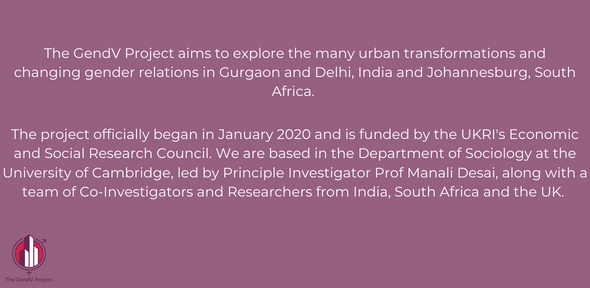What is The GendV Project?

More about the project:
Recent movements against sexual violence such as #MeToo and mass mobilizations in many countries of the global South such as India, South Africa, Brazil and Peru have brought global attention to violence against women. It is an opportune time to put forward a bold and innovative research agenda that will address why, despite decades of legislation and policy efforts, violence against women remains so high. The vision of this project is to develop a blueprint for a new generation of scholarship on gendered violence, specifically in this case public and private sexual violence. We have identified a clear need to understand this normalization by moving towards what researchers have called a ‘second wave’ of violence research that is theoretically oriented, historically sensitive, contextual, and aimed at granular analyses of violence that can inform more successful and targeted violence-reduction strategies. We will do this through a historically informed, contextualized and long-term qualitative study that is simultaneously comparative across nation-states. While large survey data and epidemiological approaches offer much insight into trends and patterns of violence, our approach will offer crucial qualitative toolkits for future researchers. Building upon a growing body of ethnographic work on gendered violence, we call for a second-wave of research that places violence within wider transformations in the political-economy of urban life and livelihoods, the attendant shifts in family forms and gender relations, and the historical legacies of racial, ethnic and other forms of categorization that in turn implicate men and women in specific relations to the state and economy.
Our aim is to create a mixed-method approach to the study of violence using the tools of ethnography, life history interviews, archival research, participant observation, and the analysis of court and police records to build an intimate neighbourhood-based approach which is deeply connected to ongoing work on violence by residents, organizations and other stakeholders. Combining depth with breadth will be the hallmark of this study; we will dig deep into neighbourhood and urban histories, tracing the evolution of gender relations within the wider transformations, paying particular attention to the intersectional analysis of power relations. At the same time, by comparing India and South Africa – two of the BRICS – we will draw out the implications of contextual findings and place them in a wider context so as to generate insights that are useful to a wider community of scholars, policy makers and practitioners in the field.
The project will explore the following questions through a comparative lens by aiming to answer these questions in each site while drawing out common patterns and differences:
(1) How is gendered violence produced and reproduced, and how and when is a violent act constituted as gendered violence? (2) How do urban transformations in both contexts relate to changing gender relations and urban life. (3)How has the family form shifted in the two cases, and what have been the consequences for women across the different demographic groups? (4) How are responses to violence shaped in light of historical, spatial, and social conditions?
Our approach critically interrogates existing explanations of gendered violence such as ‘crisis of masculinity’ or attribution of violence to poverty, slums, or other dependent variables. We suggest that while all such approaches contain a grain of truth, they fail to offer compelling narratives that show how violence is generated under such conditions for some and not others. In addition, the attribution of violence to poverty fails to consider the more hidden forms of middle-class gendered violence which is highly prevalent in our cases. Our research design, therefore, eschews an exclusive focus on the poor and instead seeks to understand violence as a cross-class phenomenon that takes different forms, occurs in different sites (public vs private), and is associated with different moral economies within specific, historically evolved caste, class, racialized and other milieus. In addition, we understand violence, drawing on the work of anthropologists of violence, as an act or series of acts that is produced and is not simply reducible to underlying factors or variables. The narratives and stories which in no small part are told by those who experience this violence, enables us to connect the ‘turning points’ at which violence develops, intensifies, and becomes normalized in the individual’s life, as well as in the wider community that is experiencing rapid shifts as a result of wider economic, political and cultural transformations.
